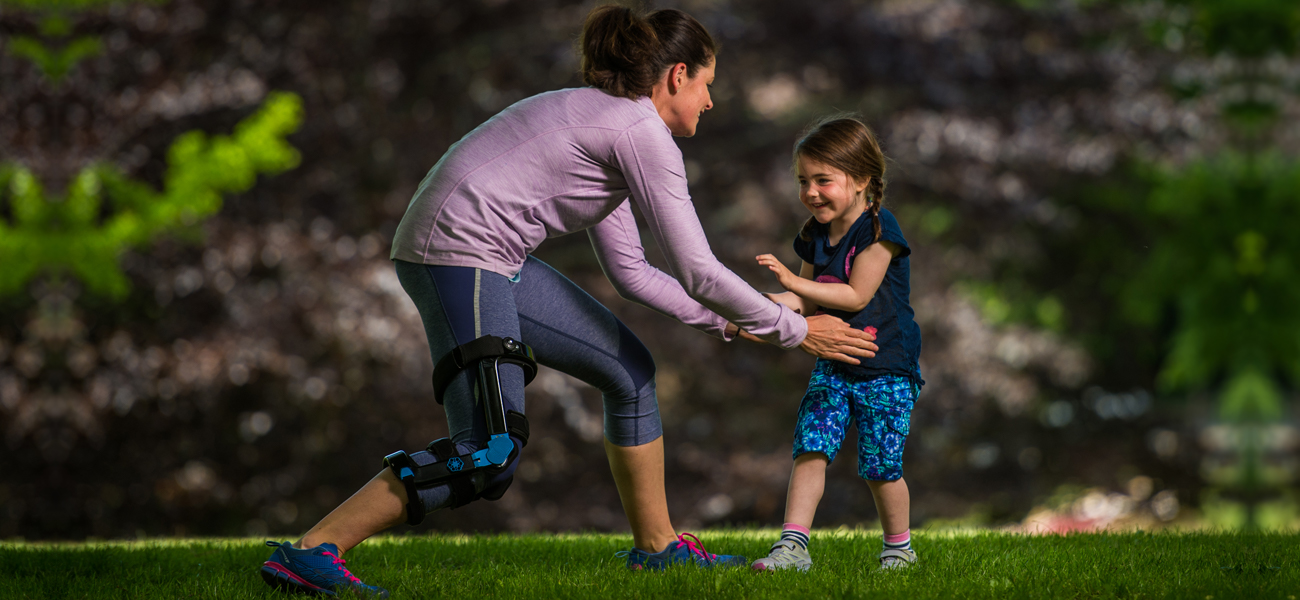Spring Loaded Technology is committed to the clinical validation of our products and technologies to ensure their efficacy, safety, and comfort. For in-depth information on our clinical research visit our healthcare professional website.
Reducing Pressure Across the Entire Knee Joint
Two studies have been completed to examine the amount of pressure and pain relief offered by a Spring Loaded knee brace:
- The first study showed that a Spring Loaded knee brace reduces contact forces in the knee joint to a level that would be achieved by losing 45 lbs of body weight1
- For an average person with knee OA that weighs 200 lbs, 45 lbs of weight loss is equal to a 22.5% reduction from their starting body weight. Previous research shows that weight loss of at least 20% is required for the best clinical outcomes2.
- The second study demonstrated that a Spring Loaded knee brace can significantly reduce patellofemoral and tibiofemoral joint contact forces (by over 40%).3
Clinical Benefits
A systematic survey of Spring Loaded brace users with knee osteoarthritis demonstrated significant clinical benefits of brace use related to pain, function, mobility, use of medication and other treatments4.
Among other key findings, this study demonstrated that:
- 100% of users with knee OA experienced a reduction in pain. The improvement in pain scores exceeded the “PASS” threshold5; that is, the pain score below which patients typically consider themselves well.
- 97.5% of users experienced significant improvements in lower extremity function. A significant improvement of 16 points was observed on the Lower Extremity Function Scale (LEFS). The minimum clinically relevant change on the LEFS is 9 points6.
- 70% of users increased their level of physical activity. Brace users were able to increase their physical activity by 2-9 hours per week, depending on their compartmental distribution of OA.
- 60% of users were able to reduce or eliminate their reliance on other treatment methods, such as injections, biomechanical aids, or allied health services.
- 27% of users who were regularly using pain medications before using a Spring Loaded brace were able to reduce or eliminate their use of medications.
- 50% of users who were considering surgery before using a Spring Loaded brace were able to delay or eliminate the need for surgery after using one.
Current Research
Spring Loaded is now running fully-controlled human performance studies in collaboration with third-party researchers to further validate the effectiveness of its bracing in individuals with knee osteoarthritis. These researchers specialize in knee joint biomechanics and knee injury and disease including osteoarthritis. Preliminary data from these studies demonstrate a positive effect of wearing the brace during activities of daily living, such as sitting and standing from a chair and going up and down stairs7.
Research Partners
Spring Loaded actively collaborates with researchers at Dalhousie University, the University of New Brunswick, the University of Calgary, and Guelph University. These researchers have provided insight into our design process and are now conducting independent testing and validation of our knee brace products in a variety of different circumstances.




Funding




For research-related inquiries, please contact emily@springloadedtech.com
- Budarick, A.R., MacKeil, B.E., Fitzgerald, S., Cowper-Smith, C.D. 2020. Design evaluation of a novel multicompartment unloader knee brace. J. Biomech. Eng. 142. https://doi.org/10.1115/1.4044818
- Messier, S.P., Resnik, A.E., Beavers, D.P., Mihalko, S.L., Miller, G.D., Nicklas, B.J., DeVita, P., Hunter, D.J., Lyles, M.F., Eckstein, F., Guermazi, A., Loeser, R.F. 2018. Intentional weight loss in overweight and obese patients with knee osteoarthritis: Is more better? Arthritis Care Res., 70(11):1569–1575.
- McGibbon, C.A., Brandon, S.C., Bishop, E.L., Cowper-Smith, C., Biden, E.N. 2021. Biomechanical study of a tricompartmental unloader brace for patellofemoral or multicompartment knee osteoarthritis. Front. Bioeng. Biotechnol. 8, doi:10.3389/fbioe.2020.604860.
- Budarick, A.R., Bishop, E., Clark, M.L. and Cowper-Smith, C. 2021. Preliminary evaluation of a new orthotic for patellofemoral and multi-compartment knee osteoarthritis. Rehabil. Res. Prac., doi:10.1155/2021/5923721.
- Tubach, F., Ravaud, P., Baron, G., Falissard, B., Logeart, I., Bellamy, N., et al. 2005. Evaluation of clinically relevant states in patient-reported outcomes in knee and hip osteoarthritis: The patient acceptable symptom state. Ann. Rheum. Dis., 64(1):34–7.
- Binkley, J.M., Stratford, P.W., Lott, S.A., Riddle, D.L., 1999. The Lower Extremity Functional Scale (LEFS): Scale development, measurement properties, and clinical application. Phys. Ther., 79(4):371–83.
- Bishop, E.L., Kuntze, G., Ronsky, J.L. 2020. Effect of a tri-compartment unloader knee brace on knee moments and quadriceps activity during a chair rise and lower and stair descent in individuals with knee osteoarthritis. Osteo.Cartil. 28:S243-S244.
